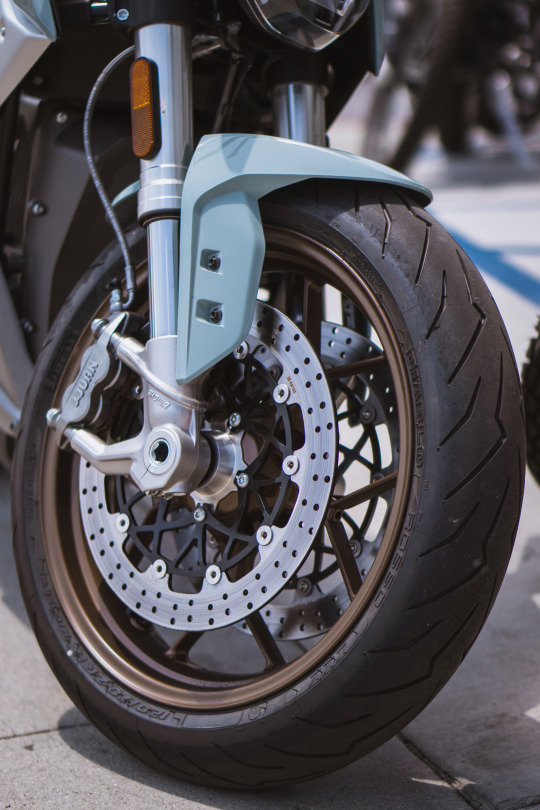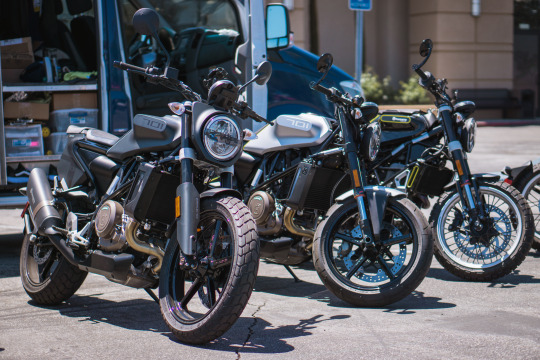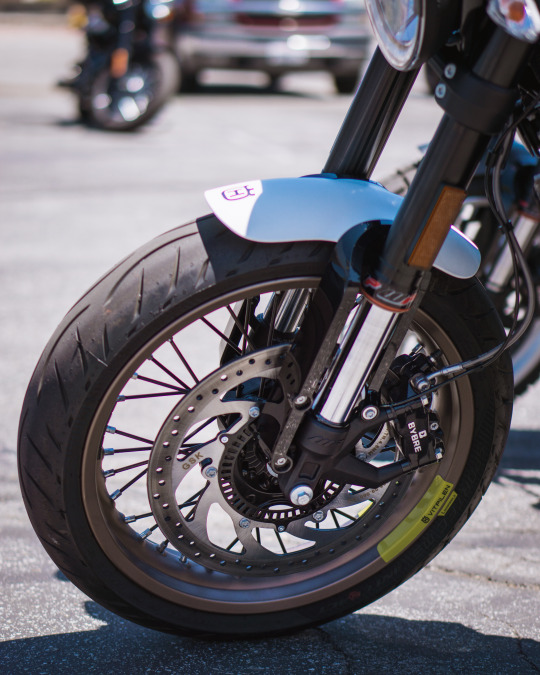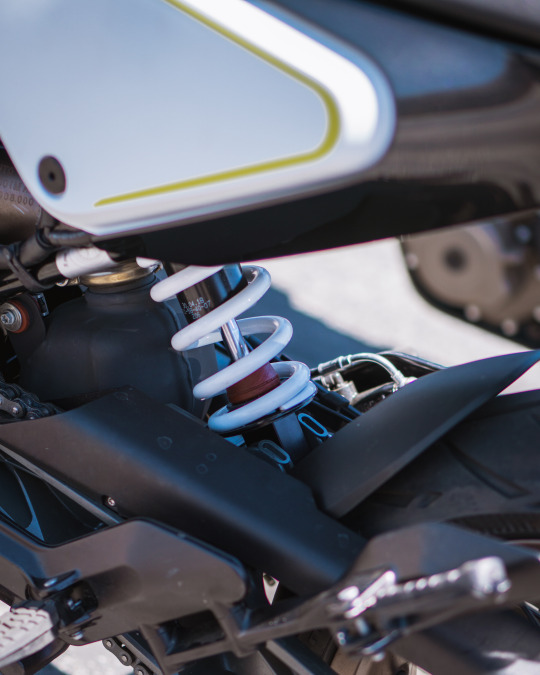#naked bikes
Harley-Davidson’s Baby Bike
Sometimes less does mean more… customers.

Yesterday, Harley announced their partnership with Chinese Manufacturer, Qianjiang Motorcycle Company Limited, to produce the smallest bike in their current lineup.
At 338cc, HD will only offer the entry-level moto in China, catering to the needs of its large and ever-growing urban population. Whether you agree with the move or not, the announcement aligns with the company’s current direction, appealing to a younger, metropolitan demographic.
With a goal to reach 50% revenue in international sales by 2027, this news marks a pivotal moment in Harley’s future plans. While the rest of the motorcycle industry turns their attention to India, gaining access to the highly restrictive Chinese market helps the Motor Company plant a flag where others are unwilling to go. This move will also help Harley explore where it’s been historically reluctant to go, design updates.

Sporting a trellis frame and an inline twin, the new bike feels miles away from your classic Harley. Where are the forward controls? How am I supposed to attach a sissy bar? Why isn’t the motor v-shaped?
Despite all the departures from HD’s vintage aesthetic, the twin thumper still retains the iconic silhouette of one of the Motor Company’s most decorated models, the XR750. Leveraging the peanut tank, the tail section, and the livery of the XR, the brand plans to draw upon its legacy to attract a new group of riders. By leaning on the racing heritage, Harley preserves the design continuity of their past and acts as a stabilizing force in the face of a rapidly changing customer base. If the technology changes, if the feeling changes, at least the design is familiar.
Harley seems to be following the approach Ford took with the Mustang and VW chose for the Beetle: they’re making what’s old new again. You could say that’s what Harley’s always done, but this time, they’re not afraid to change what’s under the hood/tank. However new, however earth-shattering the design may be to the Harley faithful, I’d be remiss to not mention how HD’s newest model eerily resembles another bike that Qianjiang manufactures, the Benelli TNT 300.

Even if they’re essentially rebranding another bike, even if the production of the bike is restricted to China, I certainly hope the model makes its way to the states (along with production [of North American units]) because the small displacement market is the fastest growing segment in the industry. New and younger riders tend to opt for smaller, lighter bikes, and the Motor Company lacks a sub-500cc offering as it stands.
You could say that the Street and Sportster acts as Harley’s beginner bikes already, but at 450 and 550 lbs respectively, many new riders (female and male) don’t consider those models manageable rigs for their first two-wheeled vehicle.
With a 338cc motor, the MoCo’s baby brawler could deliver a lower entry point for riders (in age and weight), increasing the likelihood of developing brand loyalty with younger riders.
While I think this is a great move for HOG, I can’t help but ask:
Why aren’t they going even further/smaller?
It makes me wonder why Harley doesn’t have a line of 125cc and 250cc dirt bikes. It makes me question where their 50cc and 75cc pit bikes are. If they really want to develop riders from a young age, why aren’t they making models that grow with them? Why are the majority of dirt bikes produced by Japanese and Austrian-based companies when it’s a predominantly American sport? If there’s such a big demand for dirt bikes in America, why doesn’t Harley have a dog in that fight?

In March of this year, HD purchased StayCyc, a brand that makes e-bikes for young children. At the time of the news, I saw this move as a forward-thinking. I felt that this would help the Motor Company appeal to future generations much earlier than their mid-life crisis.

But once those kids outgrow those mini electric bikes, are they supposed to wait another 10 years before they jump on an 883? Are they expected to stay loyal to Harley when competing brands offer the next immediate step up?
While this announcement is an encouraging move for Harley’s evolution, they need to address the gap between their product lineup if they’re going to retain the youngest of customers. I can only hope that their promise to introduce 100 new models in the next 10 years will fill in that gaping hole. I mean, who wouldn’t want a Harley-Davidson dirt bike?
Though I feel the introduction of a 338cc motorcycle is a good step for HD, I look forward to seeing the next foot drop. The story will only continue to develop and I’ll be rooting for them the whole way.
What do you think of the new model? What do you think of Harley producing it exclusively for China? Would you want to see more small displacement options from the Motor Company?
Let me know your thoughts in the comments.

Did you say 140 ft-lb of torque? This is gonna be fun…
My left hand extended for the clutch, but it came up empty. My left foot tapped down, but the shifter peg wasn’t there. As I rolled to a stop on Fairfax Blvd, I realized that I didn’t need to downshift. I didn’t need to rev-match. Hell, I didn’t even have to click into neutral once I was settled. What the hell was I on?
From the moment I rolled Zero’s new SR/F off the dealer’s lot, it felt like a foreign experience. Where was the grumble and burble of a combustion motor? Where was my trusty clutch lever? Where was the engine heat?
For me, motorcycles are synonymous with manual transmissions. The clutch modulates the power to the back wheel. The upshifts jolt the bike as you kick into the next gear. But with an electric motorcycle, the drive train is closer to that of a scooter, twist n’ go, and it wasn’t easy to get past that association. That is, until I hit 85 mph with the turn of the wrist!

With the lack of a transmission, the SR/F preserves as much power as possible and sends it directly to the 17″ rear wheel. Eliminating the transmission leaves us with just the engine. Can I actually call it an engine? Ok, powerplant, let’s go with that. The powerplant in the SR/F easily steals the spotlight on this bike. For touting 140 ft-lb of torque and 111 horsepower, it sure delivers all that power in a manageable fashion. I really wish I could see a dyno sheet for the bike (how would that be possible without RPM readings?), because I think it would contain the smoothest power curves known to man.
From takeoff, the torque feels like it’s closer to 70 ft-lb. It isn’t jarring. It rolls on in a controlled manner. It’s as if you were releasing the clutch slowing, though there isn’t one. But as you continue to crank the throttle, the torque ramps up and send you ripping through time and space like a fighter jet (it sorta sounds like a jet too).
Unlike Cruisers, where the torque starts out around 100 ft-lb and diminishes, or Supersports, where it tapers off while the horsepower continues to climb, the SR/F feels like the torque and horsepower escalate inseparably. It provides one of the smoothest, linear powerbands I’ve ever experienced on a motorcycle and is certainly encouraging for anyone looking to “go electric” in the future.
While I only rode on surface streets, and didn’t get a chance to toss her about in the twisties, the suspension held up like a champ. Los Angeles public roads are notorious for uneven pavement, potholes, and debris, but the suspension handled all the irregularities with ease. For me, suspension is best when it goes unnoticed and that’s exactly how I felt with the SR/F’s springs.

With fully-adjustable 43 mm Showa forks up front and a piggyback reservoir monoshock out back, the suspension is confidence inspiring and very accommodating. The ride comfort is high. The road chatter is low. The handling is predictable and snappy. Unlike the FZ-07 I rented in April, the SR/F doesn’t skimp in this category. That quality exhibits not only the capability of the bike but makes the rider want to exhibit their capabilities on the bike.
Speaking of the FZ-07, the riding posture of the SR/F is similarly neutral, if not slightly aggressive, but the attention to detail and aesthetic of Zero’s new naked truly set it apart from anything in this cluttered category and from everything else they’ve produced to this point.

The trellis frame, the futuristic front light, the tasteful mix of angles and curves all contribute the aggressive look and ultimately coalesce in a visually appealing motorcycle. For Zero, the design of the SR/F is a big leap from their past offerings. I’d compare their other models to Tesla’s lineup in the sense that they opt for a minimalistic aesthetic. When it comes to simple designs, there’s a very thin line between looking refined and looking generic. Historically, Zero’s models were on the wrong side of that fence, but the SR/F is changing that for the company. The fit and finish should be considered “premium”, and that level of quality is reflected in all the separate components of the bike, including the brakes.
With radial-mounted clampers on 320 mm dual discs, the SR/F practically stops on command. The J.Juan branded calipers pack a suitable amount of stopping power, considering they’re stopping a 500 lb bike and they aren’t emblazoned with the Brembo badge. The feel was responsive yet smooth, stiff but progressive.

Out back, you have a single 240 mm rotor and a 2-pot caliper. Compared to the robust braking components up front, the rear would seem considerably underpowered, but it does an above average job of slowing down the bike (albeit, my “average” standards are quite low, as I ride a Harley). Coupled with Bosch Advanced MSC (a fancy acronym for traction/stability control), the braking system of the SR/F upheld the premium status of the bike. Sure it doesn’t offer the name recognition of Beringer or Brembo, but they get the job done. And isn’t that what brakes should be about, getting the job done?
Now, I know what you’re probably saying:
Yeah, that’s all great and all, but would you buy one yourself?
And the short answer is no, but let me explain. The SR/F is a revolutionary machine. In my humble opinion, it marks a sea change for the electric motorcycle market and ups the ante for competitors like Lighting, and dare I say, Harley-Davidson.
But the infrastructure hasn’t caught up with the product yet. I can’t confidently say that I would (or could) go on a Pan-American trip with this or any electric motorcycle yet and that’s disheartening because I know that will act as a barrier for potential customers.
As the technology progresses and charge stations are erected, I know the viability of these machines will increase. They won’t just be considered a commuter bike. You won’t have to stay within a certain distance from home when you go for a rip about town or through the twisties. But right now, I don’t have the disposable income to spend $20K+ on a motorcycle that would need to stay regional.
Electric vehicles (cars & bikes) are the future. Whether you’re happy, excited, or ready for that change is beside the point. I fully intend to be an adopter but we’re currently in a stop gap of that transition and I need the baton to be firmly in the grasp of EVs before I make the jump (I’m never selling the Harley though). To me, it’s inevitable, but only time will tell when the takeover takes place.
However, if you have the money to purchase an SR/F, do it, now! If you’re someone fortunate to own multiple bikes, this one would be a purposeful horse in your stable. At my income level, I’m relegated to bikes that are Swiss Army knives but the SR/F could easily be your X-ACTO knife.
Whether you’re opposed to electric motorcycles or a proponent of them, do yourself a favor and give one a try. It’s a motorcycle, guys, you’d be hard pressed not to have fun.
So…would you ride an electric bike?
2019 Zero SR/F - Test Ride
**This clip was captured on a Saturday. No school children were harmed in the making of this video.
Size does matter, and in this case, smaller is better.

It’s no secret that Husqvarna’s dirt bikes and dual sports sell themselves. Touting a storied motocross/scramble history, it’s easy to see why the off-roaders are so popular with the public. On the other hand, the company hasn’t seen much success with its street-oriented lineup. With 2019s still occupying the showroom floor and the pressure of Q3 looming, Husky recently visited Azusa, California to jumpstart the sales of their Svartpilen & Vitpilen lines. Labeled the Real Street tour, the series of demo events featured both models in their 401 & 701 variations, casting a veritable spotlight on their often overlooked street bikes.
But the Svartpilen & Vitpilen aren’t afraid of the spotlight, you could even say they were crafted to bask in it. The first thing you’ll notice when you gaze at the Svartpilen & Vitpilen is the unconventional design. It’s not a stretch to say that the aesthetics of the lineup resemble something out of a Scandinavian furniture catalog. With minimal, flowing lines, the Svartpilen & Vitpilen would feel right at home with your Poäng and Klippan.
Yes, beauty is in the eye of the beholder, but the neo-retro style aims directly at a younger, urban demographic that gravitate toward classic, simplistic forms with a utilitarian edge. Whether you fancy the looks of the bikes or not, you have to admit that the fit and finish is quite impressive. However, I do feel the designers tragically overlooked the speedometer, as its more akin to a gym teacher’s stopwatch than a proper gauge. Not to mention, the highly reflective glass and mounting angle make render the information illegible. Aside from the hideous - and quite useless - instrument cluster, the Svartpilen & Vitpilen reek of smart sophistication.
But I can see how that elevated design could be a barrier for potential buyers. Due to the refined, “Swedish” aesthetics, one could quickly distinguish these models from their intra-brand cousins, KTM’s Duke and Enduro. With hopes that the public will embrace these models the same vigor as they’ve taken to KTM’s lineups, Husky is just trying to get more booties in the saddle, and I’m more than happy to oblige.

Sharing the motor of KTM’s 390 Duke and 690 Enduro R, Husky’s Svartpilen & Vitpilens benefit from two well-tested mills. Both engines push the boundaries of power that a single-cylinder engine should produce. Despite the lack of pistons to share the load, the vibrations on the 401 & 701 aren’t excessive (take that assessment with a grain of salt - I ride a Harley).
While the 701 delivers its power in a smooth, linear fashion, I found myself smitten with the 401′s punchiness. Glancing at the spec sheet, I noticed that the 701 reaches peak torque of 53 ft-lb @ 6,750 rpm with 75 hp topping out @ 8,500 rpm. Comparatively, the 401′s max torque (27 ft-lb) hits @ 6,800 rpm and horsepower (42 hp) @ 8,600 rpm. With about half the power and three-quarters of the weight of the 701, the 401 shouldn’t feel nearly as torquey. Additionally, both motors achieve max torque and horsepower at practically identical rpms, leaving me perplexed with my preference for the 401 - aside from the butt dyno.
No, I can’t support my fondness of the little thumper with cold hard data, but I can attest that the majority of the riders attending the demo agreed. I know anecdotal evidence is the least persuasive argument, but the 401 simply felt like a more agile from side-to-side and provided great acceleration in short bursts. And I may be rationalizing here, but those darting characteristics seemed appropriate for two models that translate to white arrow (Vitpilen) and black arrow (Svartpilen). The 701s weren’t bad motorcycles in the least, they just didn’t imbue the same excitement as they’re diminutive counterparts. Size does matter, and in this case, smaller is better.

But the size variation didn’t stop at the engine. The differing braking systems on the bikes occupied two different build quality standards. Even with the 401′s “budget” brakes, both systems felt well-suited for their classes with adial-mounted Brembo clampers blessing the 701s and ByBre calipers getting the job done on the 401s.
Despite the fact that both models lack dual-discs, the calipers delivered a reassuring bite while riding in urban environments. Yes, an extra rotor and caliper up front would certainly push the models in a more performance direction but we didn’t take the Svartpilen or Vitpilen into the twisties and the stock brakes would suffice where most buyers would ride these bikes - in the city.

When judging the two models on ergonomics, I kept their natural habitat - urban environments - in mind, as both maintain a fairly sporty position. Starting with the Vitpilen, I immediately noticed the aggressive, forward-leaning stance. Positioning my head directly over the front wheel, the Vitpilen made me want to slalom through mid-day traffic at full throttle. However, that state of mind prooved more enslaving than freeing. After all, I was on a demo tour. If “it’s better to ride a slow bike fast than a fast bike slow,” nothing is worse than living that platitude in reverse. If you’re looking for a nimble, aggressive, lane-splitter, the Vitpilen has you covered, but make sure your journey is manageable, as I already felt the tension in my wrists by the time we returned from the short ride.
On the other hand, the Svartpilen utilizes high-rise bars to position the rider at ease. From the upright posture, I was content to stay in line and putt along at a legally acceptable speed. Sure, I tugged on the throttle from time to time, but the relaxed stance felt more conducive to congested road conditions. If the Vitpilen’s ergonomics equate to a Supersport, the Svartpilen would be it’s Naked/Standard counterpart. Both bikes are aimed at city-dwellers and while it would be a stretch to say that either of them let you stretch your legs out, neither of them feel cramped. Though I’d probably opt for the Svartpilen in most situations, if I were visiting one of the local canyons (GMR, HWY 39, etc), I’d certainly side with the Vitpilen.

While the ergonomics shift the rider into different postures - and different states of mind - the road manners of the bikes are quite similar. With all models under 6 inches of travel, I could easily flat-foot each bike. Despite its smaller stature, the 401s benefited from the same WP 43mm inverted forks that graced the front end of the 701s. On the road, each bike was compliant and responded immediately to my every input. Particularly, the Vitpilen - with its clip-ons and head-down posture - reacted to every adjustment of my body.
Not only did the suspension allow the bikes to cut from side-to-side, it also made the 401s and 701s feel planted. From soaking up potholes to providing stable steering at speed, KTM’s proprietary suspenders highlighted how fun these machines can be. On the contrary, the lack of suspension travel on the Svartpilen did beg the question: couldn’t this model be much more fun? Aside from ergonomics and a few bits of design (paint mainly), how does the Svarpilen distinguish itself from the Vitpilen?
And that’s where I got to thinking about the lack of sales for these two models. After taking everything into consideration, it seems like Husqvarna’s “Real Street” motorcycles are going through an identity crisis. Are these bikes retro or performance? Can you consider a motorcycle “premium” (as the price would suggest) the dash looks more like a digital alarm clock and it doesn’t come with dual-disc brakes? But maybe it’s less of an identity crisis and more of a false identity. For instance, Husqvarna outfits the Svartpilen with dirt tracker styling yet they can’t endorse taking the low slung machine off-road. Even with the aesthetic hinting at dirt-capabilities, the Svartpilen is essentially a naked bike with knobbies.

Broadcasting a false image can ensnare potential buyers - or it can turn them off (like it did for me). Intoxicated by the snappy acceleration of the 401, I actually looked into purchasing a Svartpilen following the demo. But the lack of off-road capability soon soured my initial enthusiasm. If it can’t hang in the brown, why outfit it with Pirelli Scorpions? Why adopt tracker design cues? What’s the point of making form decision if it’s contrary to the function? That disillusionment made me look at the Svartpilen & Vitpilen differently.
With an MSRP of $6,299 for the 401 and $11,999 for the 701, it’s easy to see why the KTM-owned brand is having problems moving units. Coupled with the unconventional design (which I actually love but can understand how some wouldn’t), Husqvarna has it’s work cut out. Along with the lackluster sales figures of the Svartpilen & Vitpilen, the Real Street Demo stop in Azusa failed to highlight the full capabilities of models. With the near highway miles away, riders were relegated to a jaunt around the block. As a result, I never got the gearbox past 3rd and that doesn’t instill much confidence in potential customers. The combination of disorganization, bikes-to-rider ratio, wait times, and early wrap-up, I’d venture to say that the demo barely moved the needle on these two bikes.
With all that said, if you’re looking for a stylish motorcycle to ride in the city, Husky’s street lineup may be a good option. The brand continues to promote their 0% APR (up to 48 months), so you may score a new Svartpilen or Vitpilen for a great price. For my intents, the bikes are too niche in design and too specialized in purpose, but that doesn’t mean they won’t work for you. I guess the best advice I can give to potential buyers is to test ride as many motorcycles as possible. I know I will be!
